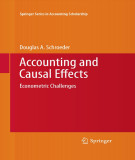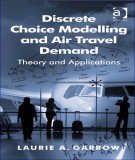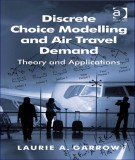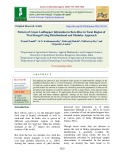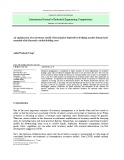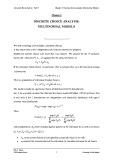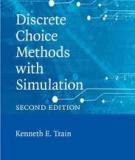
Discrete choice modelling
-
In ebook "Accounting and causal effects: Econometric challenges" we synthesize a rich and vast literature on econometric challenges associated with accounting choices and their causal effects. Identification and estimation of endogenous causal effects is particularly challenging as observable data are rarely directly linked to the causal effect of interest.
 486p
486p  tuongnhuoclan
tuongnhuoclan
 28-11-2023
28-11-2023
 6
6
 3
3
 Download
Download
-
Ebook Econometric analysis (Fifth edition): Part 2 includes contents: Chapter 15 simultaneous-equations models, chapter 16 estimation frameworks in econometrics, chapter 17 maximum likelihood estimation, chapter 18 the generalized method of moments, chapter 19 models with lagged variables, chapter 20 time-series models, chapter 21 models for discrete choice, chapter 22 limited dependent variable and duration models.
 425p
425p  haojiubujain03
haojiubujain03
 24-07-2023
24-07-2023
 7
7
 4
4
 Download
Download
-
Part 2 book "Econometric analysis" includes content: Simultaneous-equations models, estimation frameworks in econometrics, maximum likelihood estimation, the generalized method of moments, models with lagged variables, models for discrete choice, limited dependent variable and duration models, time-series models.
 425p
425p  oursky01
oursky01
 24-07-2023
24-07-2023
 7
7
 4
4
 Download
Download
-
The model suggests that the preferences for the design are influenced mainly by perceived concerns related to being too dependent on the DLC programmes, trust in the utility company that they are transparent when providing information, attitude towards and knowledge on DLC programmes. Utilities will need to carefully address these issues in the programme design to ensure a widespread acceptance.
 15p
15p  huangminghao_1902
huangminghao_1902
 27-02-2022
27-02-2022
 16
16
 2
2
 Download
Download
-
This work aims to shed light on this literature, analysing both the affordability and the accessibility energy problem of Argentine households. To do so, we use micro-data from an expenditure-survey. First, we measure the energy affordability problem by calculating the Boardman indicator. Second, we estimate two logit models to show how likely it is that the affordability energy problem explains the choice of facilities for cooking and heating that can indicate an energy accessibility problem.
 14p
14p  huangminghao_1902
huangminghao_1902
 27-02-2022
27-02-2022
 16
16
 2
2
 Download
Download
-
This study employed a discrete choice framework to explore cooking energy use patterns amongst urban Rwandan households using the latest EICV 5 microeconomic survey dataset. Specific analysis focused on choices for three primary cooking fuels namely: firewood, charcoal and liquidified petroleum gas. The findings show that ordered model provided better prediction for primary fuel choices rather than the secondary choices for multiple fuel users with income as a key determinant.
 8p
8p  caygaocaolon11
caygaocaolon11
 18-04-2021
18-04-2021
 14
14
 1
1
 Download
Download
-
Ebook Discrete choice modelling and air travel demand - Theory and applications: Part 2 present the content mixed logit; MNL, NL, and OGEV models of itinerary choice; conclusions and directions for future research.
 112p
112p  kethamoi6
kethamoi6
 01-07-2020
01-07-2020
 10
10
 1
1
 Download
Download
-
Ebook Discrete choice modelling and air travel demand - Theory and applications: Part 1 present binary logit and multinomial logit models; nested logit model; structured extensions of MNL and NL discrete choice models; network GEV models.
 194p
194p  kethamoi6
kethamoi6
 01-07-2020
01-07-2020
 14
14
 1
1
 Download
Download
-
Recognising the pattern of pest infestation helps greatly to understand the changes in the population dynamics due to several biological, environmental and climatological factors. As data are count in nature, suitable choice of distribution as well as linear or non-linear growth models are obvious to capture the variability present the population. If data are not properly fitted, integrity of scientific inference will be at stake. Hence, in the present study, an attempt has been made to fit appropriate discrete distributions along with the usual linear and non-linear modular approach.
 7p
7p  trinhthamhodang1213
trinhthamhodang1213
 30-05-2020
30-05-2020
 9
9
 0
0
 Download
Download
-
The demand of fresh item is declining with time exponentially (because no item can always sustain top place in the list of consumers’ choice practically e.g. FMCG). Shortages are allowed and backlogged, partially. Conditions for global optimality and uniqueness of the solutions are derived, separately. The results of some numerical instances are analyzed under various conditions.
 16p
16p  toritori
toritori
 11-05-2020
11-05-2020
 12
12
 0
0
 Download
Download
-
Lecture "Advanced Econometrics (Part II) - Chapter 3: Discrete choice analysis - Binary outcome models" presentation of content: Discrete choice model, basic types of discrete values, the probability models, estimation and inference in binary choice model, binary choice models for panel data.
 18p
18p  nghe123
nghe123
 06-05-2016
06-05-2016
 59
59
 6
6
 Download
Download
-
Lecture "Advanced Econometrics (Part II) - Chapter 4: Discrete choice analysis - Multinomial models" presentation of content: The multinomial logit model, conditional logit model, mixed logit mode, independence of irrelevant alternatives, nested logit model, multinomial probit model.
 13p
13p  nghe123
nghe123
 06-05-2016
06-05-2016
 71
71
 3
3
 Download
Download
-
In the subsequent section, we commence with the description of environmental inno- vation types and how these types are addressed in our analysis. Section 3 reviews the litera- ture on trends and determinants pertaining to the shift from end-of-pipe to cleaner production. Section 4 provides a descriptive summary of our data set. In Section 5, we analyze the deci- sion between end-of-pipe and cleaner production technologies using a multinomial discrete choice model.
 23p
23p  loixinloi
loixinloi
 08-05-2013
08-05-2013
 53
53
 3
3
 Download
Download
-
When I wrote my first book, Qualitative Choice Analysis, in the mid1980s, the field had reached a critical juncture. The breakthrough concepts that defined the field had been made. The basic models – mainly logit and nested logit – had been introduced, and the statistical and economic properties of these models had been derived. Applications had proven successful in many different areas, including transportation, energy, housing, and marketing – to name only a few. The field is at a similar juncture today for a new generation of procedures.
 318p
318p  951847623
951847623
 09-04-2012
09-04-2012
 102
102
 8
8
 Download
Download
-
8 A duration dependent variable. In the previous chapters we have discussed econometric models for ordered and unordered discrete choice dependent variables and continuous dependent variables, which may be censored or truncated.
 49p
49p  leslienguyen
leslienguyen
 25-11-2010
25-11-2010
 68
68
 14
14
 Download
Download
-
12 Bayesian Procedures 12.1 Introduction A powerful set of procedures for estimating discrete choice models has been developed within the Bayesian tradition. The breakthough concepts were introduced by Albert and Chib (1993) and McCulloch and Rossi (1994) in the context of probit, and by Allenby and Lenk (1994) and Allenby (1997)
 34p
34p  summerflora
summerflora
 27-10-2010
27-10-2010
 71
71
 3
3
 Download
Download
-
3 Logit Choice Probabilities By far the easiest and most widely used discrete choice model is logit. Its popularity is due to the fact that the formula for the choice probabilities takes a closed form and is readily interpretable. Originally, the logit formula was derived by Luce (1959) from assumptions about the characteristics
 42p
42p  summerflora
summerflora
 27-10-2010
27-10-2010
 63
63
 4
4
 Download
Download
-
2 Properties of Discrete Choice Models 2.1Overview This chapter describes the features that are common to all discrete choice models. We start by discussing the choice set, which is the set of options that are available to the decision maker.
 25p
25p  summerflora
summerflora
 27-10-2010
27-10-2010
 56
56
 4
4
 Download
Download
-
Bibliography Adamowicz, W. (1994), ‘Habit formation and variety seeking in a discrete choice model of recreation demand’, Journal of Agricultural and Resource Economics 19, 19–31. Ainslie, A., R. Andrews, and I. Currim (2001), ‘An empirical comparison of logit choice models with discrete vs. continuous representation of heterogeneity’
 12p
12p  summerflora
summerflora
 27-10-2010
27-10-2010
 91
91
 2
2
 Download
Download
-
Chapter 29 ECONOMETRIC ANALYSIS OF LONGITUDINAL DATA In analyzing discrete choices made over time, two arguments favor the use of continuous time models. (1) In most economic models there is no natural time unit within which agents make their decisions and take their actions. Often it is more natural and analytically convenient
 75p
75p  mama15
mama15
 30-09-2010
30-09-2010
 62
62
 5
5
 Download
Download
CHỦ ĐỀ BẠN MUỐN TÌM








